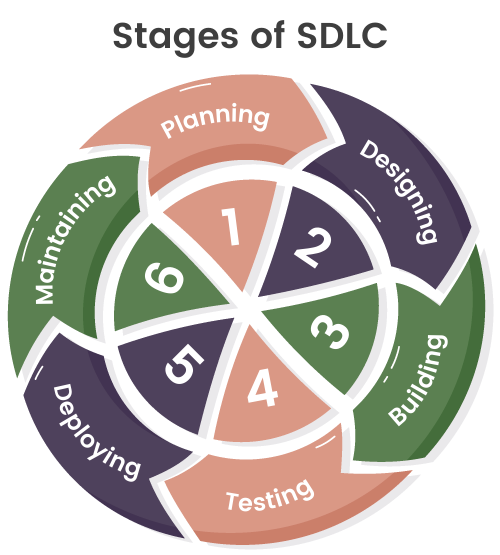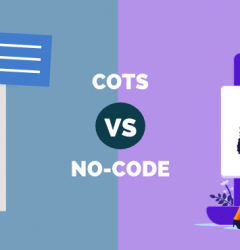
Developing an app or software through complex traditional coding is a big deal. The process is way more massive than it looks and has its own obstacles and pain points. Not just the part where the application is coded but everything that comes before and after it has complexities.
Applications and software have a life cycle of development which is known as the ‘Software Development Life Cycle’; also known as the Development process. This life cycle follows an array of steps or stages and is an essential part of any kind of development.
The Stages of SDLC
The stages of the Software Development Life Cycle cover everything in a strategic manner so that the development process is organized and the potential confusion and issues are eradicated to some extent. The Stages are defined as:

1. Planning
The planning stage of SDLC is the initial stage. In this, as the name suggests, requirements for the Software or the application are gathered and the specifications are planned carefully.
2. Designing
Only planning the specifications is NOT enough when it comes to Developing. So, in the second stage, these specifications are transformed into a more accurate ‘design plan’, and their functions are defined as well.
3. Building
The Building Stage is where actually the coding happens while developing a traditional code-based application. Thus, the design plan is turned into an actual product after this stage.
4. Testing
You cannot start using the application right after it is coded. Coding is a mind-numbing task, and thus the written codes might have errors that ultimately lead to bugs in the software. Thus, a testing stage before actually using the software or the app is very necessary as it is the stage where a lot of testing, debugging, and redoing happens. This stage makes sure that the app meets all security and quality standards before getting deployed.
5. Deploying
After the testing, the Application/software is ready to use. And thus, it is ‘deployed’; finally put into actual use.
6. Maintaining
And if you think that deploying the software marks the end of it, then you are massively wrong. This software needs a lot of operational maintenance. There’s a constant need to solve issues that arise, a lot of debugging, and even updating it with new features from time to time.
And, guess what? Adding new features to the software or application has to follow their own development life cycles, therefore, making it a never-ending vicious cycle of development.
Now, the problem certainly is not the life cycle itself as it is a very organized practice. But the real pain points come from the fact that in traditional coding, these stages of the cycle are very time-consuming and complex. However, these pain points can be solved with No-Code platforms!
Don’t believe us? Let us tell you about the pain points of the infamous SDLC and how to solve them with No-code development.
Also read: 5 ways to drive Process Improvement in your Organization
Pain points of SDLC
Pain point 1: It’s time-consuming [and costly!]
On average, through the whole life cycle, up to 50% of the time is spent on debugging and validating the software. The time could’ve been used for writing new codes but debugging, being a complex and mind-numbing task, utilizes it all when it comes to developing traditionally coded apps and software.
Complex codes written manually can have a lot of errors. According to Steve McConnell’s book, ‘Code Complete’, per 1000 lines of delivered codes has an average of 15-50 errors. These errors lead to bugs and debugging becomes important as these harmless-looking errors and bugs don’t just affect the functionality of the software but also lead to security breaches. Ultimately, the time, effort, and people involved in this consuming task cost a lot of money. 75% of the allocated budget is spent on debugging and testing the software solely.
Solution
A great replacement and solution to this problem is the use of No-Code development. No-code platforms have visual tools that work as building blocks and allow you to develop your own software and applications without writing even a single line of code. These building blocks are already tested and the potential security issues have been taken care of. Absolutely no written codes lead to few errors and about 600x fewer bugs. The few bugs that arise are also debugged faster and easier than in coded applications, making the whole process faster and economically efficient.
Pain point 2: Misaligned goals and misplaced priorities
Traditional coding demands a lot of attention to detail. Writing and testing the codes, checking for errors, and debugging requires an eye for detail. However, working so closely with the details sometimes becomes an obstacle towards seeing the bigger picture. The developers might forget about focusing more on meeting the requirements of the software and lose sight of the application in general.
With the rise of DevOps, developers don’t just develop the software but are also responsible for operational issues. Maintenance of the software takes a lot of time and effort and therefore the developers get trapped in the cycle of operational responsibilities even for the simplest of software and applications, leaving very little time to actually write new codes and build software.
Solution
This pain point can be solved with No-code development as well! No-code development is less complex as there is no written code involved. Handling the details of applications is much easier as the visual tools and drag-and-drop options let you know what exactly you are adding to the application and how it will function rather than you waiting to complete the whole process and getting surprised by the errors.
No-code also empowers the business users to make their own software and applications that are also easy to maintain as no written codes make it less complex. The operational issues are solved faster and easier, allowing more time to create than maintain.
Pain point 3: Staying up to date can be difficult
New technologies are emerging very fast and are affecting business organizations in every way possible. In such a competitive time, it is important to stay up to date. Accelerating the innovation in your software development tools doesn’t just help you stay updated but also affects the capabilities of your product and the way it performs in the market. However, traditional coding, being a very time-consuming process of development, may make it harder to keep up with the pace as you may find yourself lagging behind when it comes to using new development technologies.
Similarly, Skill sets and techniques that may be very important today may not be relevant some years down the lane. Techniques, skill sets, and processes related to development may get outdated and become irrelevant in as little time as 2 to 3 years. You may use certain technologies and techniques while building an application, but by the time it’s actually done, and you start seeing success for it in the market, your resources may have already become obsolete, making the operational maintenance of the application difficult.
Solution
No-code development can be a great solution to this problem as it is very fast and agile with a guarantee of easier maintenance. The fast pace of development helps in keeping up with the innovation and the flexibility it helps accommodate newly emerging technologies.
Watch Webinar: Learn how to test your Applications in Quixy
4 Pain points in Modeling Vs Mirroring the business domain
In organizations, Developers and IT teams often work pretty isolated from the business teams and business leaders. Such working conditions lead to a lot of miscommunication when it comes to the gathering of requirements for the software and applications that are being built.
Even after being very careful about it, there still can be a misinterpretation of given requirements leading to a lot of unnecessary features and misplaced priorities. In such situations, a lot of rework has to get done which again takes a lot of time as traditional coding practices are time-consuming. The spent time and efforts along with the delays sometimes result in missed opportunities. The misalignment of the IT and Business teams also leads to an unharmonious work environment with a lot of mistrust.
Developers also sometimes model the software rather than mirror the business requirements resulting in ideal software; the software that only works in the ideal situation rather than being an actual functional model that is compatible with the required situations given by the business leader.
Solution
No-code paves the way for business and IT teams to work closely. The business team gets to actively take part in the development of software and essential applications. No-code also empowers business users to build their own software and transform their exact vision into an actual functional product. A well-aligned business and IT team result in issues getting solved at the grassroots levels because of better communication and saves the ‘redoing’ time.
Also read: Business Process Mapping: Definition, Steps and Tips
Takeaway
No-code helps both developers and business users to overcome the SDLC pain points that come with Traditional Development. The fast, simple, easy but effective tools of development that No code platforms can potentially offer to your business will not only save a lot of time and effort but also a massive amount of money.
Quixy is one of the best No-code platforms in today’s time that offers visual tools and drag-and-drop options for development. Not just the simple applications but Quixy even lets you build enterprise-level applications that are more complex, without the hassles of traditional coding. Quixy has been empowering developers and business users with the most agile and precise development tools without compromising on security and has been recognized for its work through many awards.
Ready to transform your business? Get started now and experience the power of automation and app creation, all without the need for coding skills.
Frequently Asked Questions
1. Can No-Code platforms completely replace traditional coding in SDLC?
While No-Code platforms are extremely powerful for building applications, they may not completely replace traditional coding for highly complex projects. They are best suited for simpler, quicker applications or as tools for prototypes, with traditional coding still necessary for custom, feature-heavy software.
2. What are the key advantages of using No-Code in the SDLC?
No-Code platforms save time and reduce costs by eliminating the need for manual coding. They allow both developers and non-technical users to collaborate more easily, which leads to faster development cycles, fewer bottlenecks, and better overall efficiency.
3. Are No-Code platforms secure enough for enterprise applications?
Yes, many No-Code platforms are designed with robust security features to protect sensitive data and ensure privacy. However, it’s crucial to choose a platform that meets your specific security standards, especially when dealing with complex or regulated applications.
4. How does No-Code development influence the Software Development Life Cycle (SDLC)?
No-Code platforms streamline the SDLC by reducing the amount of time spent on coding and testing. The ease of visual development helps accelerate the stages of planning, design, and deployment, allowing applications to be created and launched faster.
5. What types of applications can be created with No-Code platforms?
No-Code platforms are versatile and can be used to build a wide variety of applications, including mobile apps, web apps, internal business tools, customer portals, and even enterprise-level applications. The flexibility allows users to create custom solutions without writing code.
Login
Please login to comment
0 Comments
Oldest















